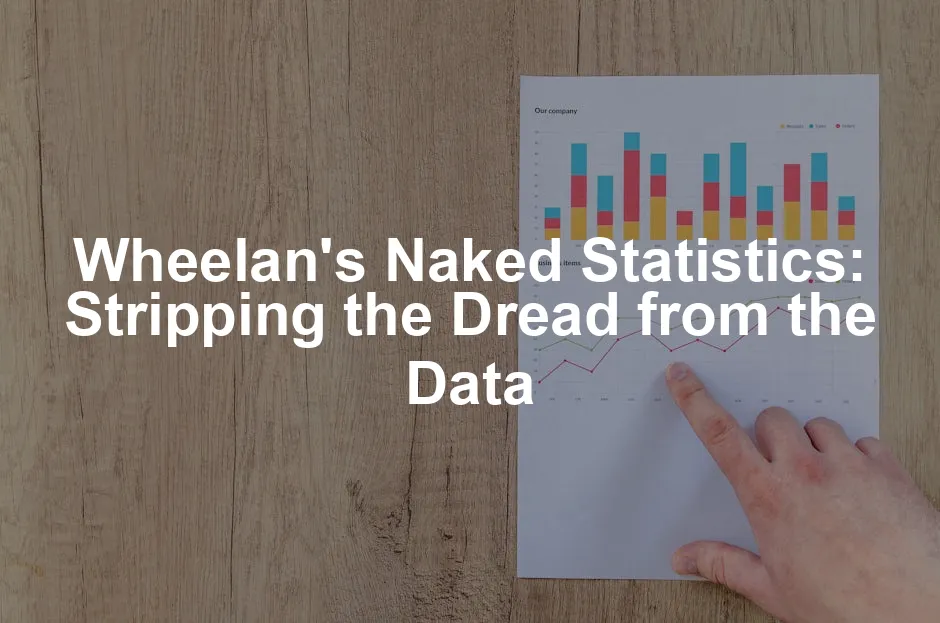Introduction
Statistics is everywhere. You might not realize it, but every scroll through your social media feed or every news article you read is laced with data. It’s the backbone of decision-making in various fields. From predicting weather patterns to analyzing consumer behavior, statistics helps us understand our world better. Yet, many people find statistics intimidating. They see numbers and run for the hills, convinced that math is a secret language meant only for the elite few.
Enter Charles Wheelan’s Naked Statistics: Stripping the Dread from the Data. This book is like a warm hug for anyone who has ever felt lost in a sea of numbers. Wheelan breaks down complex statistical concepts with humor and wit. He makes them relatable, showing that understanding statistics can be a delightful experience, not a daunting task.
The purpose of this article is to explore the key themes and insights from Wheelan’s work. We aim to provide a comprehensive guide that highlights why statistics matter and how you can grasp essential concepts without breaking a sweat. Whether you’re a student, a professional, or just a curious mind, this guide will help you see statistics in a new light. So, grab a cup of coffee, settle in, and let’s get ready to demystify the world of numbers together!

Understanding Statistics: Why It Matters
The Importance of Statistics
Why should you care about statistics? Well, let’s face it – we live in a data-driven world. Businesses use statistics to make decisions, healthcare professionals rely on them for patient care, and social scientists depend on them to understand human behavior. Statistical literacy is crucial in various fields.
Imagine you’re a business owner. You analyze sales data to determine which products are flying off the shelves and which ones are gathering dust. You might decide to invest more in popular items, all thanks to statistics guiding your decisions. In healthcare, statistics help track disease outbreaks, evaluate treatment effectiveness, and improve patient outcomes. In social science, researchers use statistics to study trends, preferences, and societal issues.
Statistics influence decision-making in everyday life too. Ever wonder how Netflix knows what movies to recommend? You guessed it – it’s all about the data! Their algorithms analyze viewing habits and preferences, helping deliver personalized content. Whether it’s the probability of rain tomorrow or the odds of winning the lottery, statistics are behind it all. And if you’re craving a deeper understanding of data analysis, check out Statistical Analysis System (SAS)—a powerful tool that can elevate your data game!

Misconceptions About Statistics
Despite their importance, many misconceptions make statistics seem daunting. One common belief is that statistics are only for mathematicians or researchers. This couldn’t be more wrong! Statistics are for everyone. You don’t need a PhD to understand basic statistical concepts. In fact, many of us use statistics in our daily lives without even realizing it.
Another misconception is that statistics are all about complex equations and formulas. While math plays a role, the core of statistics is about interpreting data and understanding what it means. If you can read a chart or understand a poll, congratulations! You’re already engaging with statistics.
Statistics can seem like a foreign land filled with intimidating jargon. However, Wheelan’s Naked Statistics serves as a passport to this land. It breaks down barriers and invites readers to see statistics as a useful tool rather than a cumbersome chore. By dispelling myths and clarifying concepts, Wheelan empowers readers to embrace statistics and use them in their decision-making processes. So, let’s cast aside those fears and dive into the fascinating world of statistics together!

Overview of *Naked Statistics*
Author Background: Charles Wheelan
Charles Wheelan is a name synonymous with engaging and accessible discussions on complex topics. He’s not just an author; he’s a former correspondent for The Economist and a seasoned educator. Wheelan teaches public policy at Dartmouth College, where he has refined his ability to break down intricate concepts into digestible bites.
His academic credentials are impressive, holding degrees from Dartmouth College, Princeton University, and the University of Chicago. This robust educational background provides the foundation for his sharp insights and humorous approach to statistics. Wheelan’s teaching style shines through in *Naked Statistics*, making it a delightful read for those intimidated by numbers. His knack for simplifying the convoluted nature of statistics, while sprinkling in humor, makes learning feel less like a chore and more like a captivating conversation.

Book Structure and Themes
*Naked Statistics* is neatly organized into chapters that progressively build on each other. Wheelan starts with fundamental concepts before delving into more complex ideas. The book kicks off by addressing the crucial question: “What’s the point of statistics?” This sets the stage for a journey through the fascinating world of data.
Key themes emerge throughout the text, including:
- Descriptive vs. Inferential Statistics: Wheelan draws a clear distinction between these two branches, explaining how descriptive statistics summarize data and inferential statistics allow us to make predictions about larger populations based on samples.
- Correlation vs. Causation: A cornerstone of statistical literacy, Wheelan emphasizes that just because two variables move together, it doesn’t mean one causes the other. It’s a common pitfall that many fall into, and Wheelan tackles it head-on with humor and clarity.
Wheelan masterfully incorporates real-life examples and witty anecdotes that make statistics relatable. Whether he’s using sports statistics to illustrate averages or discussing Netflix’s algorithms to explain predictive analysis, he connects abstract concepts to everyday experiences. This approach not only enhances understanding but also keeps readers engaged and entertained.
By the end of the book, you’ll find that Wheelan has stripped away the dread often associated with statistics. Instead of feeling overwhelmed, readers are equipped with the tools to navigate the statistical landscape confidently. Through humor and relatable situations, Wheelan invites everyone to see statistics as a valuable ally rather than an intimidating foe.

Key Concepts in *Naked Statistics*
Descriptive Statistics
Descriptive statistics serve as the foundation for understanding data. It’s all about summarizing and presenting data in a meaningful way. Think of it as the first step in a statistical analysis. These measures help us grasp the overall picture without getting lost in the details.
Key measures include:
- Mean: This is the average of a set of numbers. It’s calculated by summing all values and dividing by the count. For instance, if you’re looking at the average score of a basketball team over a season, the mean gives a quick snapshot of performance. For more insights on this, check out what does mean identically distributed in statistics.
- Median: The median is the middle value when all numbers are arranged in order. If you have an odd number of values, it’s straightforward. With an even number, it’s the average of the two middle numbers. It’s particularly useful in understanding income distributions where extremes can skew the mean. For example, see statistics poland median salary 2024.
- Mode: This is the number that appears most frequently in a dataset. If you’re a fan of sports, knowing which player has the highest scoring average can be insightful. Learn more about this in the context of statsmodels residuals statistics.
- Standard Deviation: A measure of how spread out the numbers in a dataset are. It tells us whether the data points tend to be close to the mean or far away. A low standard deviation means the numbers are clustered closely around the mean, while a high standard deviation indicates a wide range.
For example, consider sports statistics. A baseball player’s batting average serves as a descriptive statistic that summarizes their performance over a season. By examining averages, teams can make informed decisions about who to keep, trade, or bench.
In summary, descriptive statistics transform complex data into comprehensible insights, allowing us to understand trends and patterns. With Wheelan’s lively storytelling, these concepts come alive, turning what could be dry facts into relatable and enjoyable learning experiences. Statistics doesn’t have to be intimidating; it can be fun and enlightening! And if you’re looking for a solid reference, consider adding The Data Warehouse Toolkit: The Definitive Guide to Dimensional Modeling by Ralph Kimball to your reading list!

Inferential Statistics
Inferential statistics lets us make predictions about a population based on a sample. It’s like taking a tiny bite of cake to guess the flavor of the whole thing. We use inferential statistics for hypothesis testing and to create confidence intervals.
Hypothesis testing is a method to test an assumption about a population parameter. For example, say a cereal company claims their boxes contain 16 ounces. To test this, we would collect sample data and see if the mean weight significantly differs from 16 ounces. If it does, the claim might be false.
Confidence intervals provide a range of values where we expect a population parameter to fall. For example, a political poll might say a candidate has a 45% approval rating with a 3% margin of error. This means the true approval rating likely falls between 42% and 48%. This tool helps us understand the uncertainty in our estimates.
Think about polling data. If a survey shows 60% support for a new policy, that number tells us a lot. However, without understanding the margin of error and how the sample was selected, we might jump to conclusions. Thus, interpreting polling data accurately hinges on solid inferential statistics. If you’re interested in a practical guide to get started with data science, check out Data Science for Business: What You Need to Know about Data Mining and Data-Analytic Thinking by Foster Provost.

The Central Limit Theorem
The Central Limit Theorem (CLT) is a cornerstone of statistics. It states that the distribution of sample means approaches a normal distribution as the sample size increases, regardless of the population’s shape. In simpler terms, if you take enough samples, they’ll average out to a bell curve.
This theorem is crucial in quality control processes. Imagine a factory producing light bulbs. By sampling a few bulbs, we can predict the overall quality. If enough samples are taken, we can confidently say how many bulbs will likely meet quality standards. This is because the sample mean will tend to reflect the population mean, reducing the chance of costly mistakes.

Correlation and Causation
Understanding the difference between correlation and causation is vital. Just because two things seem related doesn’t mean one causes the other. For instance, a rise in ice cream sales correlates with an increase in drowning incidents during summer. This doesn’t mean ice cream causes drownings; instead, both are influenced by warmer weather.
Misinterpretation can lead to false conclusions. If a news article claims that a rise in stork populations causes more babies, it’s a classic example of confusing correlation with causation. Always look for underlying factors before jumping to conclusions!

Probability Basics
Probability lays the groundwork for understanding statistics. It’s about measuring the likelihood of an event occurring. Yet, many people fall into traps of misconception.
One common error is the Gambler’s Fallacy. This belief suggests that past random events affect future probabilities. For example, if a coin lands heads five times in a row, some might think tails is “due” next. In reality, each flip is independent.
Understanding probability is vital for risk assessment and decision-making. If you know the odds of rain tomorrow are 70%, you may choose to grab an umbrella. Making informed decisions based on probabilities can save you from soggy shoes and missed opportunities! And if you’re looking to deepen your understanding of probability, consider How to Measure Anything: Finding the Value of “Intangibles” in Business by Douglas W. Hubbard.

Real-World Applications of Statistics
Case Studies and Examples from the Book
Charles Wheelan’s *Naked Statistics* is a treasure trove of relatable examples that bring statistical concepts to life. One of the most fascinating illustrations comes from Netflix. The streaming giant uses sophisticated algorithms to analyze user data. By examining viewing habits, Netflix can recommend shows and movies tailored to individual preferences. This isn’t just guesswork; it’s a smart application of statistics. They leverage vast amounts of data to predict what you’ll want to watch next, making your binge-watching experience feel almost psychic!
Another captivating example is the analysis of standardized test scores. Wheelan discusses how these scores can be manipulated to paint an overly rosy picture of educational success. For instance, when schools know their students will be tested, they might focus solely on test-related material, neglecting a broader education. This highlights the importance of understanding the context behind statistics. A high score could indicate teaching to the test, not actual learning.
Wheelan also explores the infamous case of Target predicting customer behavior. The retail giant used statistical models to identify shopping patterns, even deducing when customers were likely pregnant based on their purchases. This level of insight into consumer behavior showcases the power of statistical analysis. It’s not just about numbers; it’s about making informed business decisions that drive success. And if you want to dive deeper into the world of statistics, consider reading The Art of Statistics: Learning from Data by David Spiegelhalter.

These examples from *Naked Statistics* reveal that statistics aren’t just abstract theories—they have real-world implications. They show how data can transform industries, enhance decision-making, and ultimately improve outcomes. Understanding these applications helps demystify statistics and illustrates their relevance in everyday life.
The Role of Statistics in Decision-Making
Statistics play a crucial role in decision-making across various fields. Professionals use statistical reasoning to inform actions and strategies, ultimately leading to better outcomes. For example, in marketing, A/B testing is a popular method. Companies test two versions of a webpage or advertisement to see which performs better. This data-driven approach helps marketers make informed choices based on actual user behavior, rather than gut feelings.
In healthcare, statistics are vital for evaluating treatment effectiveness. Doctors rely on clinical trials and statistical analyses to determine the best course of action for patients. By analyzing patient outcomes, they can make informed decisions that improve healthcare quality.
Moreover, in finance, risk assessment heavily relies on statistical methods. Investors use historical data to assess potential risks and returns, guiding their investment strategies. This analytical approach can mean the difference between profit and loss. If you’re interested in broadening your understanding of statistics in finance, check out Statistics for Dummies by Deborah J. Rumsey.

In essence, statistics empower professionals to make decisions grounded in data, leading to enhanced performance and better outcomes across various sectors. The ability to interpret and apply statistical information is a valuable skill in today’s data-driven world. Charles Wheelan’s *Naked Statistics* effectively illustrates these critical applications, encouraging readers to embrace statistics as a vital tool for informed decision-making.
Conclusion
Understanding statistics today is more important than ever. We live in a world overflowing with data. From social media feeds to financial reports, statistics help us make sense of it all. However, many people still view statistics as a daunting subject. This is where Charles Wheelan’s *Naked Statistics* comes into play.
*Naked Statistics* demystifies statistical concepts. Wheelan strips away the jargon and complexities, making statistics approachable for everyone. He uses humor and relatable examples, transforming what could be dry material into an engaging read. By breaking down statistical principles, Wheelan empowers readers to grasp these concepts easily. This book serves as a fantastic starting point for those intimidated by numbers or who feel lost in a sea of data.
Statistics is not just for mathematicians or researchers. It’s a skill that enhances critical thinking and decision-making in everyday life. Whether you’re assessing news articles or analyzing business data, statistical literacy is vital. It allows you to navigate the information overload and make informed choices. In a world where misinformation can spread like wildfire, understanding statistics gives you the tools to critically evaluate the claims you encounter.
So, don’t shy away from statistics! Embrace it as a valuable skill. Engage with Wheelan’s Naked Statistics for a fun and enlightening experience. By doing so, you’re not just learning numbers; you’re enhancing your ability to think critically, understand trends, and make smarter decisions. Let’s strip the dread from data together!

FAQs
What is the primary focus of *Naked Statistics*?
The primary focus of *Naked Statistics* is to make statistics accessible and engaging for readers, especially those with little to no background in the subject. Wheelan aims to simplify key concepts and demonstrate their relevance to everyday life.
Who is the target audience for *Naked Statistics*?
*Naked Statistics* is targeted towards beginners, students, and professionals. Anyone looking to enhance their statistical literacy will find this book beneficial. It’s particularly useful for those who want to understand the role of statistics in various fields without getting overwhelmed by technical details.
How does Wheelan’s writing style contribute to the book?
Wheelan’s writing style is characterized by humor and relatable examples. This approach makes complex concepts easier to understand and enjoyable to read. His friendly tone invites readers to engage with the material, making statistics feel less intimidating.
Can I apply the concepts from *Naked Statistics* in my daily life?
Absolutely! The book provides practical insights that help you interpret data encountered in news articles, social media, and professional settings. By understanding statistics, you can make more informed decisions and critically evaluate the information presented to you.
Where can I find *Naked Statistics*?
*Naked Statistics* is available at major bookstores, online retailers like Amazon, and libraries. You can easily find it in various formats, including paperback, eBook, and audiobook. So, grab your copy and start your journey into the world of statistics!
Please let us know what you think about our content by leaving a comment down below!
Thank you for reading till here 🙂
All images from Pexels




